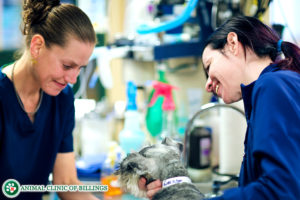Double Pelvic Osteotomy (DPO)
What is a Double Pelvic Osteotomy (DPO)?
The Double Pelvic Osteotomy (TPO) is a surgery closely related to the Triple Pelvic Osteotomy (TPO), in which the pelvic bones are manipulated to alter the orientation of the hip socket (called the acetabulum) in such a way as to improve joint function and reduce instability, pain, and future degenerative changes in puppies with hip dysplasia. During this procedure, cuts are made through two of the pelvic bones (the ilium and pubis) adjacent to the area where they meet to form the hip socket (acetabulum). After these cuts have been made, the portion of the pelvis containing the hip socket can be rotated slightly to increase the surface area of the socket that will cover the top of the femoral head (the “ball” of the hip joint). Even without the third bone cut performed in the TPO, enough rotation can be achieved, though it does slightly alter the position of the ischium (the “seat bone” of the pelvis). This bone segment is then secured in place with a custom-designed surgical plate.
Benefits from a Double Pelvic Osteotomy
The primary indication for this surgery is to address the joint instability present in young dogs with hip dysplasia in order to prevent the future development of degenerative joint changes that would otherwise cause life-long pain and loss of mobility. This procedure is only effective in dogs that do not yet have significant remodeling or any arthritic changes, and that have mild to moderate joint laxity. Typically, only patients from 5 months old up to about 12 months old meet these criteria. This is a relatively invasive surgery, and has a moderate risk of complications.
It is important to spay or neuter any patient that undergoes this procedure, both because the change to the shape of the pelvis can interfere with a female’s ability to give birth, and because hip dysplasia is a genetic condition that would likely be passed on to offspring. It is challenging to definitively determine which puppies with hip joint laxity will go on to develop clinical hip dysplasia and therefore would benefit from this surgery, so there is a risk that some patients who undergo this procedure may ultimately not have needed it. At this time, there is not a reliable way to predict the progression of symptomatic hip dysplasia in a puppy with signs of hip joint laxity.
What is the Prognosis with the Double Pelvic Osteotomy?
This surgery provides a very good to excellent outcome for patients under 12 months old who have mild to moderate hip joint laxity and who lack any signs of degenerative changes. Older patients, those with severe laxity, and those that already have degenerative joint changes, are less likely to experience the intended benefit of this procedure.
What are the potential complications of this surgery?
The DPO is a fairly invasive procedure that has a moderate risk of complications. It is somewhat less invasive than the Triple Pelvic Osteotomy, and appears to have a slightly lower risk of complications. The most common complication is loosening or breakage of the surgical screws. This complication is most frequently encountered in large, male puppies who were too active in the first two months following surgery. Usually this complication does not require another surgery, but strict confinement is essential until the pelvic bones have fully healed. Because the surgical area contains several large nerves and blood vessels, there is a risk for nerve damage and potentially serious hemorrhage during surgery. This risk is lowest for surgeons who are very experienced performing TPO’s. The potential for complications can be minimized by using careful surgical technique and strictly complying with post-operative instructions.
What is recovery like after the procedure?
Following surgery, most patients spend two to three days in the hospital to ensure that they are comfortable on oral pain medications and are able to ambulate with the assistance of a belly sling prior to going home. Strict activity restriction is essential for the first six to eight weeks after the patient goes home, and sling support is used when walking for the first two weeks. Controlled, low-impact exercises are introduced starting about two weeks after surgery. X-rays are evaluated at four and eight weeks after surgery to evaluate implant integrity and bone healing. Only after bone healing is complete will a return to full activity be permitted.
What if my dog is not a candidate for DPO?
Dogs that do not meet the criteria for DPO surgery may benefit from a Femoral Head and Neck Ostectomy (FHO) or a Total Hip Replacement (THR).

Let our highly trained and experienced team of veterinarians and veterinary technicians help you keep your cat as happy and healthy as they can be.
Call the Animal Clinic of Billings and Animal Surgery Clinic to schedule your pet cat’s next wellness examination with one of our veterinarians today!
406-252-9499 REQUEST AN APPOINTMENT



